The first day of the Premier League season provided the neatest picture of the coin of Mikel Arteta at the Arsenal across both sides. And, in a nutshell, it was a big victory to resilient Arsenal but still work to be undertaken by new look Gunners, a verdict which puts much needed three precious points and flawed performance which earned them the three points. It was not the sparkling, free flowing football that drove their last season, but with a gritty, no-nonsense attitude that has already made itself a refreshing new attribute, that the 2-1 win at the Selhurst Park was secured.
Although the three points are a priceless starting point to build on their performance itself was oftentimes very fragmented and it is no doubt a testament to just how tough it is to incorporate new faces and an ambitious tactical shift at that. It was a test of character, which Arsenal came out of, with flying colours though the strategic analysis may show there are a number of areas which need urgent repair. This sloppy win might end up being the more accurate gauge to their claim of significance when compared to any easy knockout game.
Part I: The Match Unfolds – A Tale of Frustration and Fortitude
A first game against Crystal Palace on the road is the type of Premier League baptism by fire. It has an intimidating atmosphere, it is physical, and the outcome is how the story is going to shape itself for the weeks to come. Arsenal arrived in this cauldron not only to claim victory, but to display their new more rugged version.
An Afternoon of High Stakes and Tactical Surprises
This drama started an hour before the real-time. The publishing of the team sheet showed that Mikel Arteta plans not only to consolidate but evolve as well. One of the most profound strategic changes he released was done with the abandonment of the highly stable two-pivot in midfield to the more attacking 4-3-3. This new formation involved Declan Rice playing as a solitary holding midfielder, a position that required a lot of him since he had to protect the entire defence. In the forward of his front, Martin Ødegaard and new boy Kai Havertz were released as twin advanced midfielders, or number 8s. Nothing like leaving your defensive solids to make explosive gamble. This was the message: Arsenal planned to take over the opponents in a different and more overpowering manner.
First-Half Frustrations
The gap between theory and the actual reality on the field was obvious. The opening 45 was calamitous and frustrating to the guests. The characteristic passes that form the triangles in the game of Arsenal were substituted with misdirected passes and poor decision makings. The new midfield with its fluid interaction structure appeared bulky and out of touch. Rice found himself in the isolated position and the flow between him and his highly positioned partners was leveraged continually with Palace making quick turns. These were deprived of slick service, and the attack was useless, unable to raise lasting pressure or to generate openings, lanes and gaps. One can draw a gloomy picture of the team unable to adapt to the new attitude with help of the statistical results of the first 45 minutes.
The Breakthrough: A Set-Piece Lifeline
As the game progressed, it was plain that it would take a moment of personal flair, or a pre-determined piece of magic to unlock the stalemate. The latter eventuated to be the case. Having lost that open-play rhythm, and resolving to seek out another, equally powerful weapon in their armoury: the set-piece. The corner was a perfect delivery by Bukayo Saka and the header by William Saliba was a thunderous one like in several of last year as well. It was a reflection of how scrupulous the work of set-piece coach Nicolas Jover had been and an essential top-down injection of quality into a game that has, up to that point, been sorely lacking it.
Holding the Fort: A Test of Defensive Mettle
The second was scored just as abruptly–it came not out of some flowing movement, but out of an instant of stinging opportunism. Swiftly canceling out the go-ahead goal of the home side was a crafty free kick turnover that saw Gabriel Jesus foul to present a penalty to Saka that he cruised through. Once they led by two goals, the priority was not to find fluency any more but to ensure the outcome. The last twenty minutes were a backs-to-the-wall job, a measure of defensive organisation of the team and its unity. Each of the players demonstrated a great sense of defense where they defended, ran after runners, blocked shots, and fought out each second ball. It was not pretty but it was deeply effective with a resilience that has been often impugned in years gone by.
Part II: The Tactical Debrief – Deconstructing Arteta’s Blueprint
To comprehend how the day went we have to go beyond the outcomes and deconstruct the managerial motives. The tactical change that Arteta induced was a risk calculated to transform his team into rivals into title-winners.
The Grand Plan: What Arteta Was Trying to Achieve
The switch to 4-3-3 and one pivot is a high-risk and high-rewards tactic endeavored by some of the best teams in world football. The theoretical benefits are obvious:
- Constancy of Attacking Pressure: The team will press to overload its opponents in their half through pushing two midfielders forward with the aim of creating continuous pressure on the opponents by pinning them in their own half.
- Creative Freedom: The model will aim at relieving the needs of the players such as Ødegaard and Havertz of the defensive constraints of a two-pivot and will leave them more creative energy to generate and to score.
- Aggressive Counter-Pressing: Greater numbers of players playing higher up the field is beneficial in allowing the team to press as soon as they lose the ball when they can win it back in more dangerous positions before the opposition are able to counter attack.
Promise and Problems: An Honest Assessment
The game gave some glimpse of what this blueprint could do. The rotations between Havertz and forwards at times left the Palace defence in some confusion. But the evils were all the more apparent. And the main flaw of the system, the exposure of the lone holding midfield player was brutally followed out. Declan Rice, in a stern attempt, found himself more often than not deserting an unsurmountable distance between himself and the ball gifting the home team many counter-attacking chances. The middle three were not the right combination to act as one team player but as separate players then a unit, which is home to many exit.
A Spotlight on the Anchor: Declan Rice’s Demanding New Role
There was pressure on no player more than Declan Rice. His transfer of 105 million of pounds with enormous expectations, and his new position can be regarded as the core of success or failure of Arsenal. His mixed-bag performance was characterized, on the one hand, by his heroic defensive efforts, and on the other hand, by his isolated instances. The statistics of the game helps to visualize the amount of work he was requested to do.
Rice showed how great an individual quality he has had but it was also revealed in the performance that he cannot be made to do the job of two men. To make the system work, the supporting defenders have to provide much more disciplinary midfield air cover by advanced midfielders.
Part III: The Verdict – Title Ambitions and The Road Ahead
One game cannot make a season but it can show the character of a team. This win is in a very dirty way, not perfect at all and provides an interesting impression of the new Arsenal and how ready they look to claim another title.
The Hallmarks of a Champion? The Art of ‘Winning Ugly’
The Manager’s Perspective: Arteta’s Post-Match Reaction
Those words by Mikel Arteta in his post-match press conference were both a representation of the day and two-sided. He was effusive in stating the character and resilience of the team stating the win at a hard venue as a massive three points. Nevertheless, he was also not afraid to judge the performance harshly, saying that “we were not at our best” and that “we have so much to put right in our structuring and bonding.” This frank assessment is imperative; it demonstrates that the manager is not lost in the outcome and knows what hard work is required at the training ground.
Conclusion: A Foundation of Resilience, A Ceiling Yet to Be Reached
The final verdict is that this opening day win is more hopeful in the sense it made of Arsenal and their character than on their ability. A combination as hapless as this last season would have led maybe to a frustrating draw or at least, a one-nil defeat. This year it obtained three points. That is the evident visible growth.
The squad has already shown that it now possesses not only mental strength and defensive unity to be able to win matches despite misfiring in attack. This durability gives them an excellent foundation to their campaign. Nonetheless, the tactical evolution can no longer help but bear its fruits to achieve the ceiling needed to win the Premier League. The possibilities of what the new system can do are immense, yet the journey to unleash its potential will be long and difficult with heavy amounts of patience, hard work and the players on-field chemistry having to improve by a great margin. Grit is the basis of a champion and Arsenal started that basis on the first day. Now the labor starts to create a masterpiece on it.
Final Thoughts
After all is said and done, three points in the opening day match were all that mattered. This was a victory however that was more of a triumph of a matter of character than of substance. The determination and toughness shown are exactly what Arsenal have long been lacking when having a title shot come up. But Mikel Arteta is well aware that such a degree of tactical disconnection is just not tenable against the elite of the league. It was a victory that sets a background of character and the blueprint to their masterpiece is yet to be developed.




